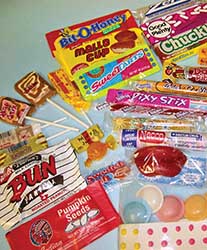Food Packaging = Psychophysical Remediation
PACKAGING
 The food packaging community has always been aware of the power of the physical entity referred to as the package. Color, shape, dress, graphic elements, and adjuncts define the product for the consumer on the retail shelf, in the pantry, and even on the table. Think for a moment of the delights conjured up by viewing an image of the M&M’s™ Peanut Chocolate Candies pouch: a bold yellow background evoking peanuts and rich brown lettering suggesting chocolate—together a mouthful of psychic and physical pleasure. The product’s benefits have been translated into an instantaneous picture to trigger responses that lead to purchase and use. The notion that packaging is a form of marketing has driven the design of food packages since the 19th century.
The food packaging community has always been aware of the power of the physical entity referred to as the package. Color, shape, dress, graphic elements, and adjuncts define the product for the consumer on the retail shelf, in the pantry, and even on the table. Think for a moment of the delights conjured up by viewing an image of the M&M’s™ Peanut Chocolate Candies pouch: a bold yellow background evoking peanuts and rich brown lettering suggesting chocolate—together a mouthful of psychic and physical pleasure. The product’s benefits have been translated into an instantaneous picture to trigger responses that lead to purchase and use. The notion that packaging is a form of marketing has driven the design of food packages since the 19th century.
Even though a food package is primarily a protective mechanism for food products, the role of packaging in distribution, delivery, and communication at many points in channels and use is evident. It may even be regarded as a psychological tool linking the visual to the mind and sparking the decision to eat. But now folks in the United Kingdom have moved the food package into the realm of the alleviation of dementia and Alzheimer’s disease. Ancient and long-forgotten candy packages are being presented to patients to remind them of the good old days—the joy and flavor of Aero, Smarties®, Rowntree’s® Fruit Gums, and others in a reminiscence pack. The sweets’ packages reportedly resurrect vivid memories of earlier and happier times in the minds of cognitively impaired individuals. Nestlé UK and Ireland have developed this system in conjunction with the UK Alzheimer’s Society to apply objects familiar from past decades to help ease symptoms of dementia.
DementiaAfflicting some 800,000 persons in the United Kingdom and 35 million worldwide, dementia is incurable. Dementia is not a single disease but a non-specific syndrome affecting cognitive functions such as memory, attention, language, and problem-solving. In later stages, subjects may be disoriented in time (what year is it?), in space (where am I?), and in person (who am I?). One of the most common forms of dementia is Alzheimer’s disease. Although there is no treatment to eliminate all of the symptoms, mental stimulation has been found to be one mechanism to help patients. Memories of encounters with pleasure—i.e., candy packaging—can apparently jog the brain.
The phrase “use it or lose it” might be applied to the brain relative to dementia. Intellectual activities help keep the mind alert as a person ages. Activities such as reading or playing a musical instrument can postpone the onset and slow the progression of Alzheimer’s and other forms of dementia. Psychosocial interventions can be classified within behavior-, emotion-, cognition-, or stimulation-oriented approaches.
Emotion-oriented interventions include reminiscence therapy, supportive psychotherapy, sensory integration, and simulated presence therapy. Reminiscence therapy involves bringing up past experiences with the aid of photographs, household items, music and sound recordings, or other familiar items from the past, such as the packaging of favorite confectioneries. Although there are only a few quality studies on the effectiveness of reminiscence therapy, it appears to be beneficial for cognition and mood. The aim of cognition-oriented treatments, which include reality orientation and cognitive retraining, is the reduction of cognitive deficits.
Nestlé’s Reminiscence Pack
The attempt in the United Kingdom to assist patients and their caregivers to slow the onset of dementia and extend the useful lives of victims is an incremental push to ally food and its packaging to human health. Historically, confections have suffered from providing great pleasure and calories to being responsible for almost all ills of humankind: diabetes, obesity, acne, cavities, etc.
The symbolism of candy—the brightly colored and sparkling crinkle of packaging—was and possibly still is a stimulus for the real happiness derived from the eating experience. Nestlé dove into its archives to identify current and former products that may enable patients to tap into long-term memories. Nostalgic versions of famous UK brands such as Rowntree’s® Dairy Box have been revived as well as many that no longer exist on the British market. According to Nestlé, the images were taken from company archives kept in a special purpose climate controlled facility in their York factory, where items such as works of art, films, products, and packaging are preserved. Preliminary results have been positive. The results are so intriguing that other health support groups have inquired about resurrecting the past to enhance the future.
--- PAGE BREAK ---
The Candy Man Syndrome
Accolades go to the late Sammy Davis Jr. for having validated the consumption of sweets in the United States. During those days, the staid old one-color graphics that identified the flavor of a nickel bar were standard. Then came the genius of designers Lippincott & Margulies, Raymond Loewy, Roy Parcels, and many others who reinvented the confectionery industry by demonstrating which package color and form could be integrated with the product to favorably affect sales and subsequent consumption. Suddenly the appearance of the five-cent unit of sale became a blaze of visual effects that heralded the great bite and flavor of Snickers®, the scintillating fruity aroma of Starburst® Fruit Chews, or the cool burst of a York® Peppermint Pattie. Youthful consumers came to associate remembered visuals with the joy of savoring the product. The two were inseparable in the consumer’s mind.
Contemporary artist Brendan O’Connell asserts that “labels are inseparable from life. Memories are populated by people and places and packaging.” Therein lies the potential for boosting the health-improving effects of candy packaging: the close linkages of package design, size, format, and shape with the texture and flavor of the chocolate or sugar candies embedded in pleasurable memories.
Mature American readers might favorably recollect their initial encounters with Tootsie Roll®, Charleston Chew®, Bit-O-Honey®, Sen Sen®, Necco® Wafers, or Mary Jane® candy. Whether or not any of these, some of which are still available in the United States, would have a similar effect on age-related cognitive decline as other brands do in Great Britain remains to be seen. For sure, all evoke wonderful memories that should generate positive mindsets among viewers. I suspect that other food product packaging might be just as effective in conjuring memories and emotions that ease the impaired mind: e.g., the red and white of a Campbell’s® Tomato Soup label, the blue and yellow box of Kraft® Macaroni & Cheese Dinner, or the multi-colored balloons on a bag of Wonder® Bread.
It is an exciting thought that the images of those wraps could offer at the very least a spark of hope for actually alleviating some of the symptoms of dementia. Never before had anyone considered candy packaging to have direct health-giving properties, but this is the 21st century, the time of sensory universality.
 Packaging Research: A Path to the Consumer’s Mind
Packaging Research: A Path to the Consumer’s Mind
In more than half a century of working in food packaging, I have been fortunate to work with a host of professionals, some of whom have been the cadre of those who developed the observation of consumer response to packaging. Because food-packaging design has become a major element of packaging engineering and functionality, research to quantify the effects of appearance should become much more important. Investigation into the interactions of the package and the user have included classical reactions to color, fostered by Ernest Dichter, interpretation from Art Harkham of Lipton, comprehension by consultant Mona Doyle, and even the measurement of eye iris diameter or electrical impulses in the brain when confronted with a visual image. Today, the realm of consumer responses belongs to the driving efforts of psychophysicist Howard Moskowitz, who probes deeply into minds to quantify their instant and long-term responses and reasoning to provide real bases for package (and product) design.
 Aaron L. Brody, Ph.D., CFS, Contributing Editor
Aaron L. Brody, Ph.D., CFS, Contributing Editor
President and CEO, Packaging/Brody Inc., Duluth, Ga., and Adjunct Professor,
University of Georgia
[email protected]
